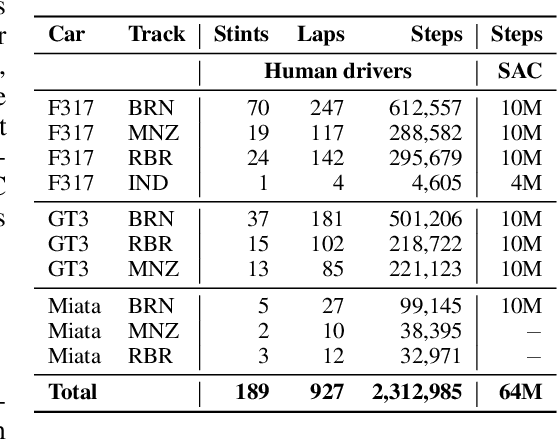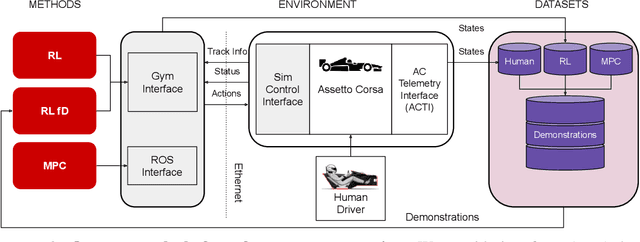Marko Bertogna
BETTY Dataset: A Multi-modal Dataset for Full-Stack Autonomy
May 12, 2025Abstract:We present the BETTY dataset, a large-scale, multi-modal dataset collected on several autonomous racing vehicles, targeting supervised and self-supervised state estimation, dynamics modeling, motion forecasting, perception, and more. Existing large-scale datasets, especially autonomous vehicle datasets, focus primarily on supervised perception, planning, and motion forecasting tasks. Our work enables multi-modal, data-driven methods by including all sensor inputs and the outputs from the software stack, along with semantic metadata and ground truth information. The dataset encompasses 4 years of data, currently comprising over 13 hours and 32TB, collected on autonomous racing vehicle platforms. This data spans 6 diverse racing environments, including high-speed oval courses, for single and multi-agent algorithm evaluation in feature-sparse scenarios, as well as high-speed road courses with high longitudinal and lateral accelerations and tight, GPS-denied environments. It captures highly dynamic states, such as 63 m/s crashes, loss of tire traction, and operation at the limit of stability. By offering a large breadth of cross-modal and dynamic data, the BETTY dataset enables the training and testing of full autonomy stack pipelines, pushing the performance of all algorithms to the limits. The current dataset is available at https://pitt-mit-iac.github.io/betty-dataset/.
A Simulation Benchmark for Autonomous Racing with Large-Scale Human Data
Jul 24, 2024



Abstract:Despite the availability of international prize-money competitions, scaled vehicles, and simulation environments, research on autonomous racing and the control of sports cars operating close to the limit of handling has been limited by the high costs of vehicle acquisition and management, as well as the limited physics accuracy of open-source simulators. In this paper, we propose a racing simulation platform based on the simulator Assetto Corsa to test, validate, and benchmark autonomous driving algorithms, including reinforcement learning (RL) and classical Model Predictive Control (MPC), in realistic and challenging scenarios. Our contributions include the development of this simulation platform, several state-of-the-art algorithms tailored to the racing environment, and a comprehensive dataset collected from human drivers. Additionally, we evaluate algorithms in the offline RL setting. All the necessary code (including environment and benchmarks), working examples, datasets, and videos are publicly released and can be found at: https://assetto-corsa-gym.github.io
Guess the Drift with LOP-UKF: LiDAR Odometry and Pacejka Model for Real-Time Racecar Sideslip Estimation
May 09, 2024Abstract:The sideslip angle, crucial for vehicle safety and stability, is determined using both longitudinal and lateral velocities. However, measuring the lateral component often necessitates costly sensors, leading to its common estimation, a topic thoroughly explored in existing literature. This paper introduces LOP-UKF, a novel method for estimating vehicle lateral velocity by integrating Lidar Odometry with the Pacejka tire model predictions, resulting in a robust estimation via an Unscendent Kalman Filter (UKF). This combination represents a distinct alternative to more traditional methodologies, resulting in a reliable solution also in edge cases. We present experimental results obtained using the Dallara AV-21 across diverse circuits and track conditions, demonstrating the effectiveness of our method.
A Tricycle Model to Accurately Control an Autonomous Racecar with Locked Differential
Dec 22, 2023Abstract:In this paper, we present a novel formulation to model the effects of a locked differential on the lateral dynamics of an autonomous open-wheel racecar. The model is used in a Model Predictive Controller in which we included a micro-steps discretization approach to accurately linearize the dynamics and produce a prediction suitable for real-time implementation. The stability analysis of the model is presented, as well as a brief description of the overall planning and control scheme which includes an offline trajectory generation pipeline, an online local speed profile planner, and a low-level longitudinal controller. An improvement of the lateral path tracking is demonstrated in preliminary experimental results that have been produced on a Dallara AV-21 during the first Indy Autonomous Challenge event on the Monza F1 racetrack. Final adjustments and tuning have been performed in a high-fidelity simulator demonstrating the effectiveness of the solution when performing close to the tire limits.
er.autopilot 1.0: The Full Autonomous Stack for Oval Racing at High Speeds
Oct 27, 2023



Abstract:The Indy Autonomous Challenge (IAC) brought together for the first time in history nine autonomous racing teams competing at unprecedented speed and in head-to-head scenario, using independently developed software on open-wheel racecars. This paper presents the complete software architecture used by team TII EuroRacing (TII-ER), covering all the modules needed to avoid static obstacles, perform active overtakes and reach speeds above 75 m/s (270 km/h). In addition to the most common modules related to perception, planning, and control, we discuss the approaches used for vehicle dynamics modelling, simulation, telemetry, and safety. Overall results and the performance of each module are described, as well as the lessons learned during the first two events of the competition on oval tracks, where the team placed respectively second and third.
Uncovering the Background-Induced bias in RGB based 6-DoF Object Pose Estimation
Apr 17, 2023Abstract:In recent years, there has been a growing trend of using data-driven methods in industrial settings. These kinds of methods often process video images or parts, therefore the integrity of such images is crucial. Sometimes datasets, e.g. consisting of images, can be sophisticated for various reasons. It becomes critical to understand how the manipulation of video and images can impact the effectiveness of a machine learning method. Our case study aims precisely to analyze the Linemod dataset, considered the state of the art in 6D pose estimation context. That dataset presents images accompanied by ArUco markers; it is evident that such markers will not be available in real-world contexts. We analyze how the presence of the markers affects the pose estimation accuracy, and how this bias may be mitigated through data augmentation and other methods. Our work aims to show how the presence of these markers goes to modify, in the testing phase, the effectiveness of the deep learning method used. In particular, we will demonstrate, through the tool of saliency maps, how the focus of the neural network is captured in part by these ArUco markers. Finally, a new dataset, obtained by applying geometric tools to Linemod, will be proposed in order to demonstrate our hypothesis and uncovering the bias. Our results demonstrate the potential for bias in 6DOF pose estimation networks, and suggest methods for reducing this bias when training with markers.
CERBERUS: Simple and Effective All-In-One Automotive Perception Model with Multi Task Learning
Oct 03, 2022



Abstract:Perceiving the surrounding environment is essential for enabling autonomous or assisted driving functionalities. Common tasks in this domain include detecting road users, as well as determining lane boundaries and classifying driving conditions. Over the last few years, a large variety of powerful Deep Learning models have been proposed to address individual tasks of camera-based automotive perception with astonishing performances. However, the limited capabilities of in-vehicle embedded computing platforms cannot cope with the computational effort required to run a heavy model for each individual task. In this work, we present CERBERUS (CEnteR Based End-to-end peRception Using a Single model), a lightweight model that leverages a multitask-learning approach to enable the execution of multiple perception tasks at the cost of a single inference. The code will be made publicly available at https://github.com/cscribano/CERBERUS
Motion Planning and Control for Multi Vehicle Autonomous Racing at High Speeds
Jul 22, 2022



Abstract:This paper presents a multi-layer motion planning and control architecture for autonomous racing, capable of avoiding static obstacles, performing active overtakes, and reaching velocities above 75 $m/s$. The used offline global trajectory generation and the online model predictive controller are highly based on optimization and dynamic models of the vehicle, where the tires and camber effects are represented in an extended version of the basic Pacejka Magic Formula. The proposed single-track model is identified and validated using multi-body motorsport libraries which allow simulating the vehicle dynamics properly, especially useful when real experimental data are missing. The fundamental regularization terms and constraints of the controller are tuned to reduce the rate of change of the inputs while assuring an acceptable velocity and path tracking. The motion planning strategy consists of a Fren\'et-Frame-based planner which considers a forecast of the opponent produced by a Kalman filter. The planner chooses the collision-free path and velocity profile to be tracked on a 3 seconds horizon to realize different goals such as following and overtaking. The proposed solution has been applied on a Dallara AV-21 racecar and tested at oval race tracks achieving lateral accelerations up to 25 $m/s^{2}$.
DCT-Former: Efficient Self-Attention with Discrete Cosine Transform
Mar 03, 2022


Abstract:Since their introduction the Trasformer architectures emerged as the dominating architectures for both natural language processing and, more recently, computer vision applications. An intrinsic limitation of this family of "fully-attentive" architectures arises from the computation of the dot-product attention, which grows both in memory consumption and number of operations as $O(n^2)$ where $n$ stands for the input sequence length, thus limiting the applications that require modeling very long sequences. Several approaches have been proposed so far in the literature to mitigate this issue, with varying degrees of success. Our idea takes inspiration from the world of lossy data compression (such as the JPEG algorithm) to derive an approximation of the attention module by leveraging the properties of the Discrete Cosine Transform. An extensive section of experiments shows that our method takes up less memory for the same performance, while also drastically reducing inference time. This makes it particularly suitable in real-time contexts on embedded platforms. Moreover, we assume that the results of our research might serve as a starting point for a broader family of deep neural models with reduced memory footprint. The implementation will be made publicly available at https://github.com/cscribano/DCT-Former-Public
All You Can Embed: Natural Language based Vehicle Retrieval with Spatio-Temporal Transformers
Jun 18, 2021



Abstract:Combining Natural Language with Vision represents a unique and interesting challenge in the domain of Artificial Intelligence. The AI City Challenge Track 5 for Natural Language-Based Vehicle Retrieval focuses on the problem of combining visual and textual information, applied to a smart-city use case. In this paper, we present All You Can Embed (AYCE), a modular solution to correlate single-vehicle tracking sequences with natural language. The main building blocks of the proposed architecture are (i) BERT to provide an embedding of the textual descriptions, (ii) a convolutional backbone along with a Transformer model to embed the visual information. For the training of the retrieval model, a variation of the Triplet Margin Loss is proposed to learn a distance measure between the visual and language embeddings. The code is publicly available at https://github.com/cscribano/AYCE_2021.
 Add to Chrome
Add to Chrome Add to Firefox
Add to Firefox Add to Edge
Add to Edge